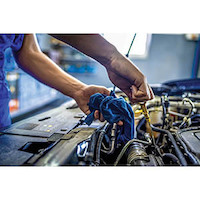The following are some of the parts and features involved in vehicle operation.
It's been said it takes a village to raise a child. And when it comes to cars and trucks, scores of components are required to ensure a vehicle is operational. Various parts must work in concert to power a car or truck. Drivers may not fully understand the roles of the key components under the hood and elsewhere. The following are some of the parts and features involved in vehicle operation.
· Engine: The engine is the most important component in a gas-powered vehicle. Without it, the vehicle would not move. Most modern vehicles are powered by an internal combustion engine, which creates energy by igniting a mixture of fuel and air. Increasingly, however, customers are opting for electric motors that store energy in rechargeable batteries.
· Cooling system: This component keeps the engine at a temperature that is optimal to prevent overheating. It consists of a radiator that transfers heat from the hot engine coolant to the atmosphere; a water pump that forces coolant to circulate; and a thermostat to regulate the engine's operating temperature.
· Transmission: The transmission is a complex system of gear sets, hydraulic torque converters, and clutches and bands. Automatic transmissions work automatically to shift to accelerate and decelerate as needed for a smooth driving experience. Drivers control a manual transmission. AutoZone notes there's also a continuously variable transmission that continuously adjusts the transmission ratio to optimize fuel efficiency.
· Battery and alternator: The battery stores energy so it can be released as electricity to run the vehicle's electrical components. The alternator is responsible for generating electricity for the vehicle, but also to recharge the battery.
· Catalytic converter: This part is a component of the exhaust system. It is an emissions control device that will transform dangerous exhaust gases into water, carbon dioxide and nitrogen.
· Brakes: The brakes on a vehicle slow it down and enable it to come to a stop. Cars will have disc or drum brake systems. Disc brakes include calipers, rotors and pads. The calipers are housings for the brake pads and are responsible for converting hydraulic pressure when the driver presses the brake pedal into mechanical force. The brake pads create friction against the brake rotor (a spinning disc), generating the force needed to stop the car.
· Shock absorbers: A car ride would be very rough and bumpy without a suspension system. Shock absorbers are springs that smooth out the ride by ensuring the tires remain in contact with the road surface. Worn shocks can cause vibrations and uneven tire wear.
· Starter and solenoid: The starter is responsible for turning the engine's crankshaft. When the ignition is engaged, it moves a small gear called a pinion. Then the starter motor spins, cranking the engine to initiate the combustion process. The solenoid is an electro-mechanical switch between the battery and the starter that receives an electrical signal when the vehicle ignition is engaged. The solenoid powers the starter, which helps to crank the engine.
· Steering system: The steering components transfer input from the steering wheel to the front wheels. Modern cars have power steering, which reduces the amount of effort needed to turn the steering wheel. The steering wheel rotates the steering column, which rotates the pinion gear that connects to a rack that extends the width of the vehicle. As the pinion rotates, it pushes the rack, which then moves the tie rods and steering knuckles on the front tires.
Vehicles have hundreds of parts that work together to start and move the car so that people can effortlessly get from point A to point B.


